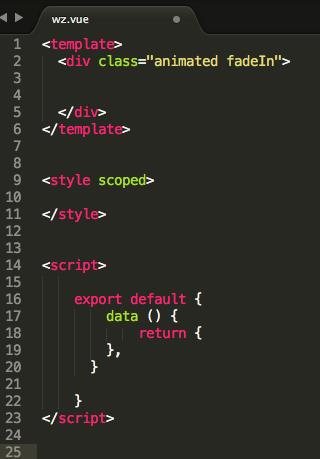一步步带你做vue后台管理框架——上手使用
Posted herozhou工巧
tags:
篇首语:本文由小常识网(cha138.com)小编为大家整理,主要介绍了一步步带你做vue后台管理框架——上手使用相关的知识,希望对你有一定的参考价值。
系列教程《一步步带你做vue后台管理框架》第二课
github地址:vue-framework-wz
线上体验地址:立即体验
闲扯再多不会用也没白搭,这节课我来带大家直接上手框架,体验到简单方便之后你就会爱上这个框架欲罢不能的。
首先跟所有的vue项目一样,两种方式,一种去项目github地址:vue-framework-wz上下载代码包到本地,或者使用
git clone https://github.com/herozhou/vue-framework-wz.git
无论哪种方式,只要我们能够拿到整个代码包就行。在我们代码包的根目录下打开命令行,执行如下命令:
npm install --registry=https://registry.npm.taobao.org
建议大家最好使用这样的方式,cnpm总是会出现各种奇怪的bug。
等到依赖安装完成之后我们运行
npm run dev
然后在浏览器中输入http://localhost:9001,就可以直接看到我们的主界面了。
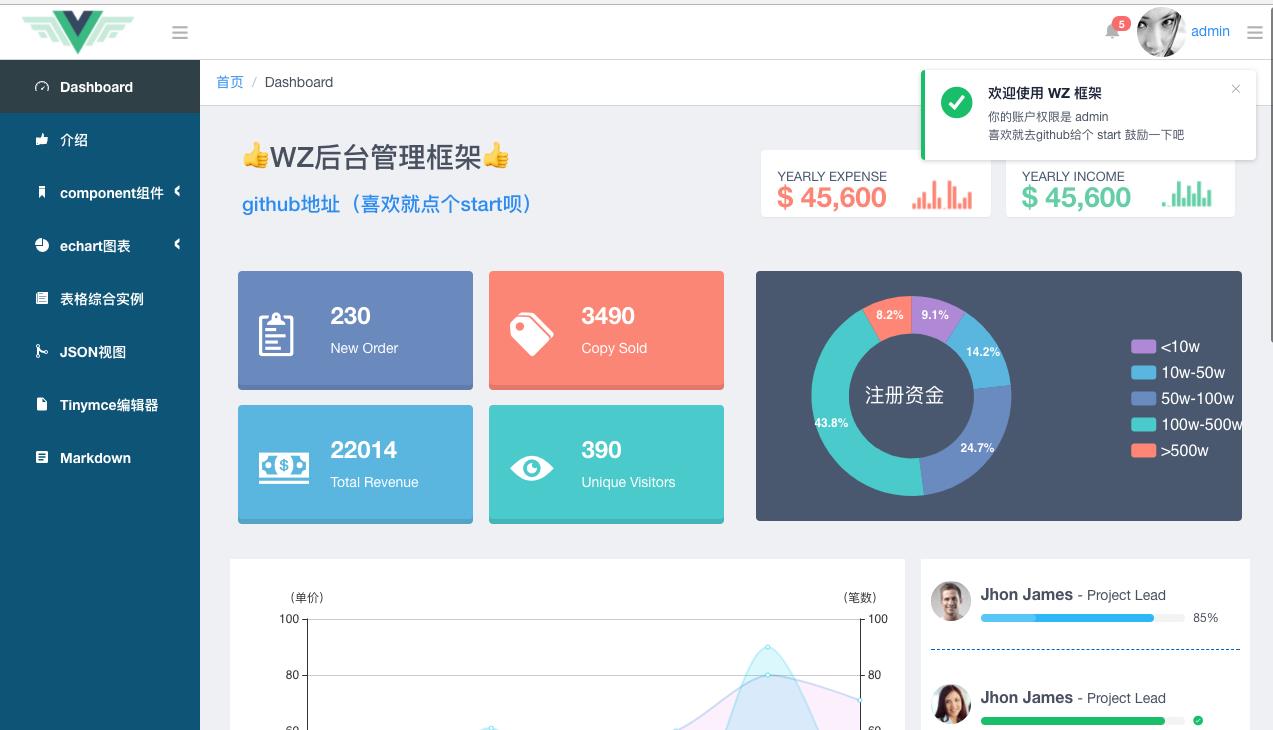
这是一个很粗糙的首页,我们接下来要学习如何做一个自己的界面。
打开编辑器,进入到vue-framework-wz/src/views文件夹下,新建一个vue文件,名字就叫做wz.vue,然后定义好一个vue组件的dom模板,如下图。
我们写点什么呢?先写一个简单标题能看到效果吧。
<template> <div class="animated fadeIn"> <h3>框架在手,天下我有</h3> <p>好用的框架决定了一个程序员的效率</p> </div> </template>
如果我们想要有自适应的效果怎么办?加上Row行组件和Col列组件,并设置好Col的属性
<template> <div class="animated fadeIn"> <Row> <Col :sm="24" :md="24" :lg="12"> <h3>框架在手,天下我有</h3> <p>好用的框架决定了一个程序员的效率</p> </Col> </Row> </div> </template> <script> export default { data () { return { } } } </script>
这样就很简单的做好了一个页面,接下来就要配置路由了,进入到vue-framework-wz/src/router/index.js文件,把我们的组件引入进来,然后在下面配置好我们的路由,如下所示。
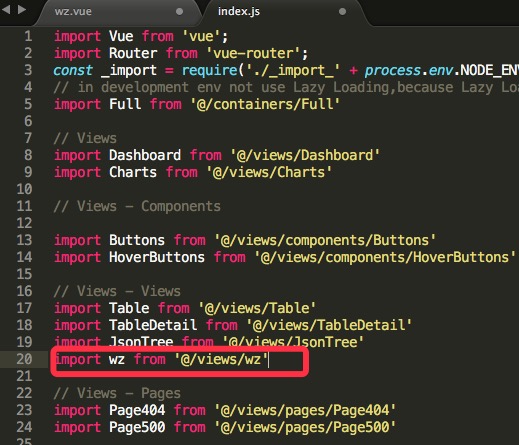
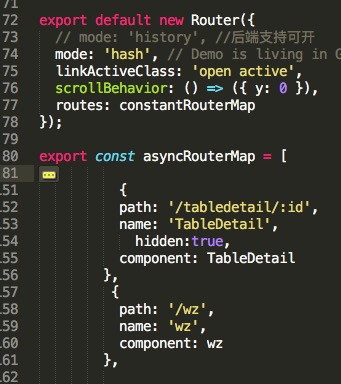
完整index.js代码
import Vue from \'vue\'; import Router from \'vue-router\'; const _import = require(\'./_import_\' + process.env.NODE_ENV); import Full from \'@/containers/Full\' import Buttons from \'@/views/components/Buttons\' // Views - Pages import Page404 from \'@/views/errorPages/Page404\' import Page500 from \'@/views/errorPages/Page500\' /* login */ const Login = _import(\'login/index\'); Vue.use(Router); export const constantRouterMap = [ { path: \'/login\', component: Login, hidden: true }, {path: \'/pages\',redirect: \'/pages/p404\', name: \'Pages\', component: { render (c) { return c(\'router-view\') } // Full, }, children: [{path: \'404\', name: \'Page404\', component: _import(\'errorPages/Page404\') }, {path: \'500\',name: \'Page500\',component: _import(\'errorPages/Page404\')}, ] } ] export default new Router({ mode: \'hash\', linkActiveClass: \'open active\', scrollBehavior: () => ({ y: 0 }), routes: constantRouterMap }); export const asyncRouterMap = [ { path: \'/\', redirect: \'/dashboard\', name: \'首页\', component: Full, hidden:false, children: [ {path: \'/dashboard\',name: \'Dashboard\',icon:\'speedometer\',component: _import(\'Dashboard\')}, {path: \'/introduction\',name: \'介绍\',icon:\'thumbsup\',component: _import(\'Introduction\')}, {path: \'/components\',name: \'component组件\',redirect: \'/components/buttons\',icon:\'bookmark\', component: {render (c) { return c(\'router-view\') }}, children: [ {path: \'buttons\',name: \'Buttons按钮\',icon:\'social-youtube\',component: _import(\'components/Buttons\'), hidden:false, }, {path: \'hoverbuttons\',name: \'悬停特效按钮\',icon:\'wand\',component: _import(\'components/HoverButtons\')}, {path: \'alert\',name: \'Alert警告提示\',icon:\'alert\',component: _import(\'components/Alert\')}, {path: \'card\',name: \'Card卡片\',icon:\'ios-browsers-outline\',component: _import(\'components/Card\')}, {path: \'datepicker\',name: \'DatePicker\',icon:\'ios-calendar-outline\',component: _import(\'components/DatePicker\')}, {path: \'form\',name: \'Form表单\',icon:\'ios-list-outline\',component: _import(\'components/Form\')}, {path: \'modal\',name: \'Modal对话框\',icon:\'ios-chatbubble-outline\',component: _import(\'components/Modal\')}, {path: \'select\',name: \'Select选择器\',icon:\'ios-arrow-down\',component: _import(\'components/Select\')}, {path: \'spin\',name: \'Spin加载中\',icon:\'load-d \',component: _import(\'components/Spin\')}, {path: \'steps\',name: \'Steps步骤条\',icon:\'ios-checkmark-outline\',component: _import(\'components/Steps\')}, {path: \'timeline\',name: \'Timeline时间轴\',icon:\'android-more-vertical\',component: _import(\'components/Timeline\')}, {path: \'transfer\',name: \'Transfer穿梭框\',icon:\'ios-pause-outline\',component: _import(\'components/Transfer\')}, {path: \'timepicker\',name: \'Timepicker\',icon:\'ios-clock-outline\',component: _import(\'components/Timepicker\')}, {path: \'upload\',name: \'Upload上传\',icon:\'ios-cloud-upload-outline\',component: _import(\'components/Upload\')}, ] }, {path: \'/charts\',name: \'echart图表\',redirect: \'/charts/shopchart\',icon:\'pie-graph\', component: {render (c) { return c(\'router-view\') }}, children: [ {path: \'shopchart\',name: \'商场统计图表\',icon:\'stats-bars\',component: _import(\'charts/ShopChart\'), hidden:false, }, {path: \'radarchart\',name: \'雷达图\',icon:\'arrow-graph-up-right\',component: _import(\'charts/RadarChart\')}, {path: \'cakechart\',name: \'蛋糕销量图表\',icon:\'ios-analytics\',component: _import(\'charts/CakeChart\')} ] }, {path: \'/table\', name: \'表格综合实例\',icon:\'ios-paper\',component: _import(\'Table\'),meta: { role: [\'admin\'] }}, {path: \'/jsontree\', name: \'JSON视图\',icon:\'merge\',component: _import(\'JsonTree\')}, {path: \'/tabledetail/:id\',name: \'TableDetail\', hidden:true, component: _import(\'TableDetail\')}, {path: \'/tinymce\',name: \'Tinymce编辑器\',icon:"android-document",component: _import(\'Tinymce\')}, {path: \'/markdown\',name: \'Markdown\',icon:"android-list",component: _import(\'Markdown\')}, {path: \'/wz\',name: \'WZ\',icon:"social-html5",component: _import(\'wz\')}, ] }, { path: \'*\', redirect: \'/pages/404\', hidden: true } ];
然后打开我们的浏览器进入到http://localhost:9001/#/wz
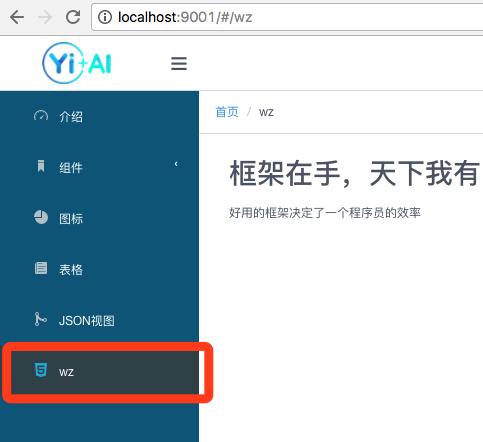
页面就显示出来了,而且侧边栏已经自动遍历可访问的路由生成列表项了。
很方便吧?
接下来我们进阶一下,看看如何做一个表格。
首先加入Table标签,
<Table :columns="columns1" :data="data1"></Table>
再配置列和data属性:
export default { data () { return { columns1: [ { title: \'姓名\', key: \'name\' }, { title: \'年龄\', key: \'age\' }, { title: \'地址\', key: \'address\' } ], data1: [ { name: \'王小明\', age: 18, address: \'北京市朝阳区芍药居\' }, { name: \'张小刚\', age: 25, address: \'北京市海淀区西二旗\' }, { name: \'李小红\', age: 30, address: \'上海市浦东新区世纪大道\' }, { name: \'周小伟\', age: 26, address: \'深圳市南山区深南大道\' } ] } }, }
这样简单的表格就做好了
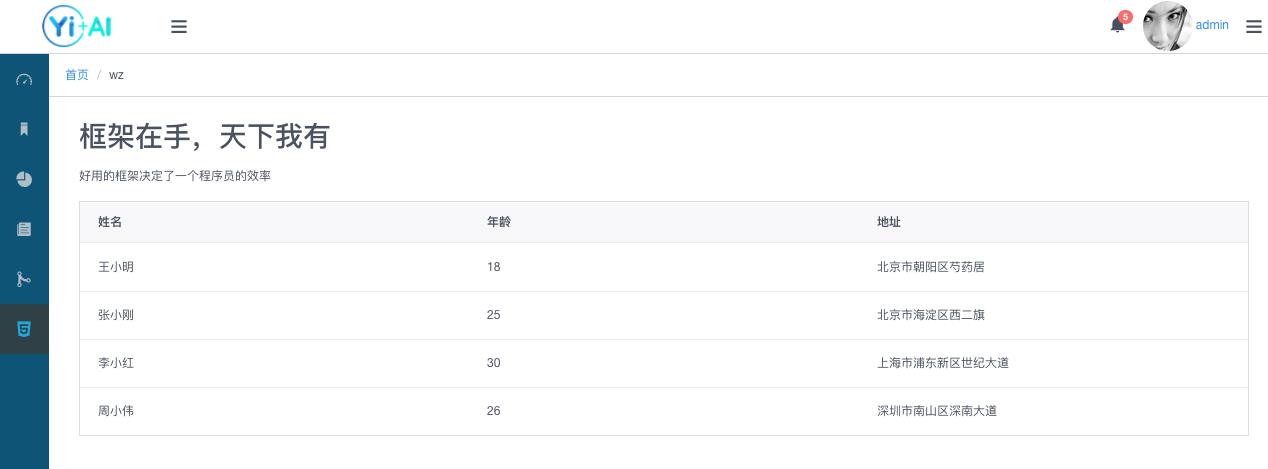
怎么在表格中加入按钮呢,比如查看,删除?
这就用到vue的render函数了。
在columns1中加入一个新的属性,是一个render函数。
{ title: \'操作\', key: \'action\', width: 150, align: \'center\', render: (h, params) => { return h(\'div\', [ h(\'Button\', { props: { type: \'primary\', size: \'small\' }, style: { marginRight: \'5px\' }, on: { click: () => { this.show(params.index) } } }, \'查看\'), h(\'Button\', { props: { type: \'error\', size: \'small\' }, on: { click: () => { this.remove(params.index) } } }, \'删除\') ]); } }
如果对render函数很陌生的话,移步vue文档学习一下render函数。
然后我们加入一些功能函数,实现查看和删除功能。
methods: { show (index) { this.$Modal.info({ title: \'用户信息\', content: `姓名:${this.data1[index].name}<br>年龄:${this.data1[index].age}<br>地址:${this.data1[index].address}` }) }, remove (index) { this.data1.splice(index, 1); } },
当我们点击查看就会出现一个对话框,点击删除就会移除这一行
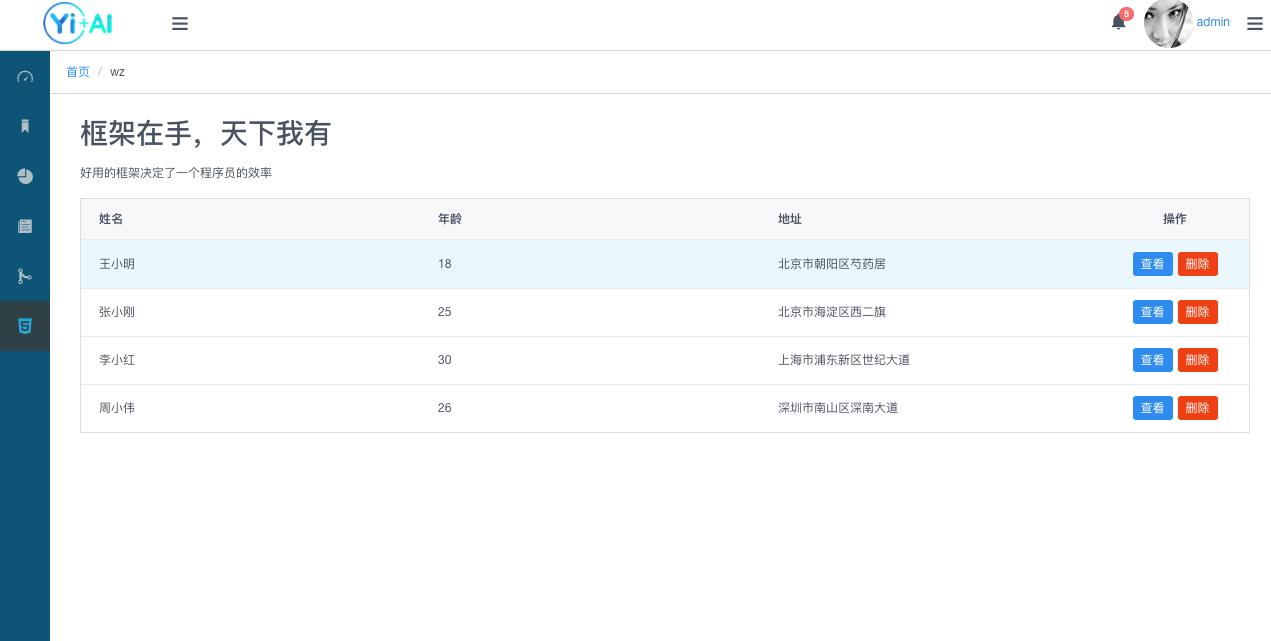
大家有什么问题最好去我github提issues,文章评论评论较长时间才查看一次。
接下来的教程讲一下封装UI组件、router、webpack、node命令行构建工具等内容。
希望大家看了这系列教程都能制作出自己的前端框架,从而在工作中得心应手。
如果喜欢就点个start鼓励下作者吧。
github地址:vue-framework-wz
线上体验地址:立即体验
以上是关于一步步带你做vue后台管理框架——上手使用的主要内容,如果未能解决你的问题,请参考以下文章

